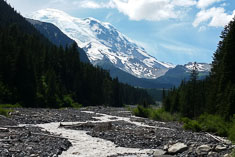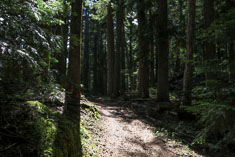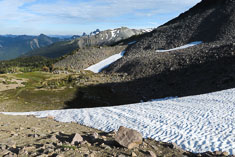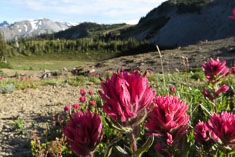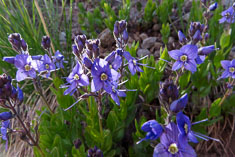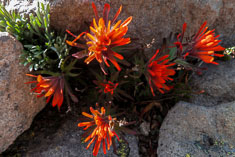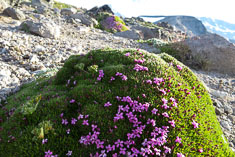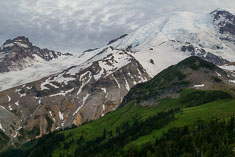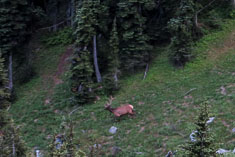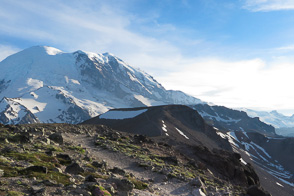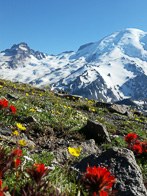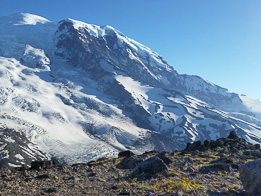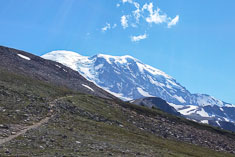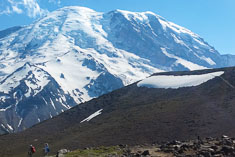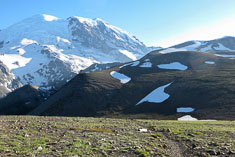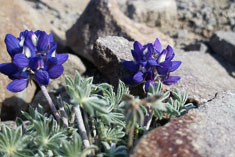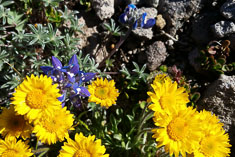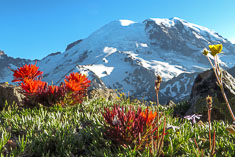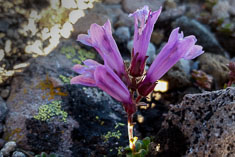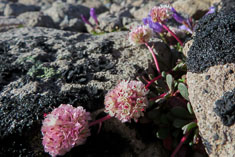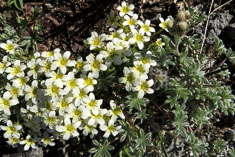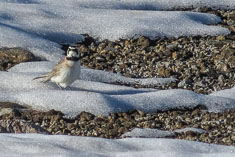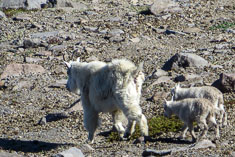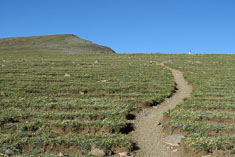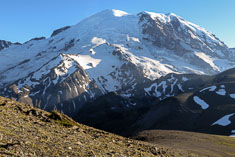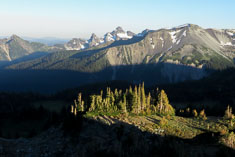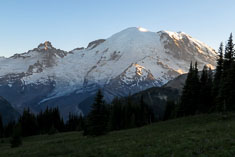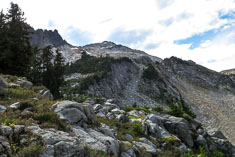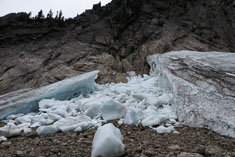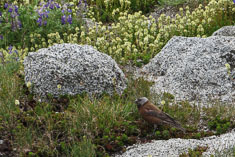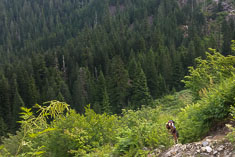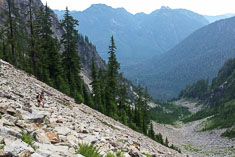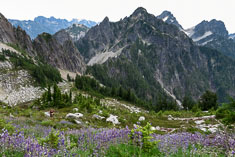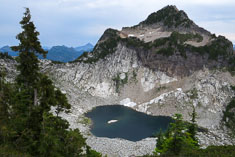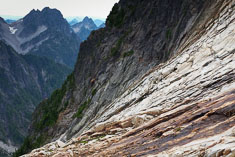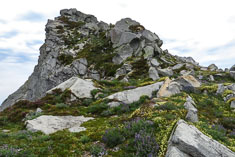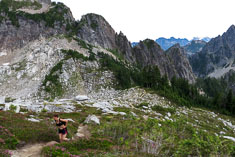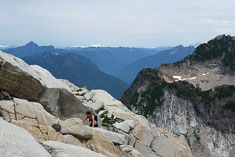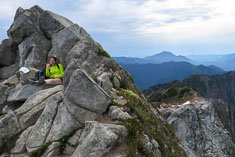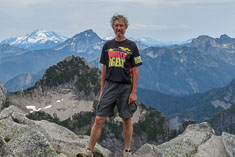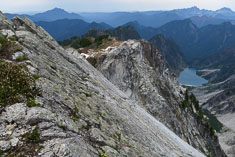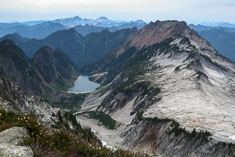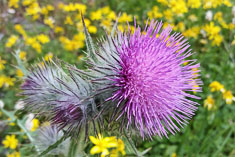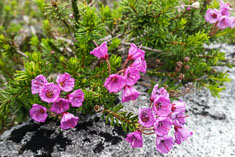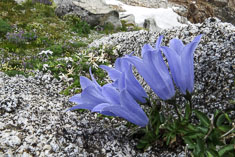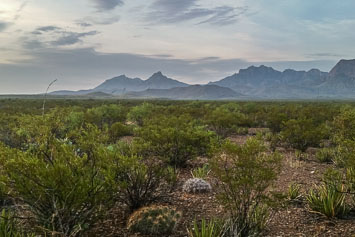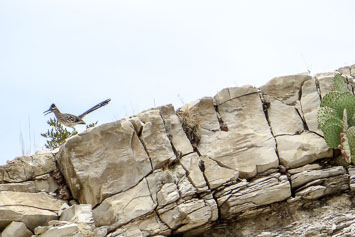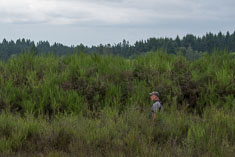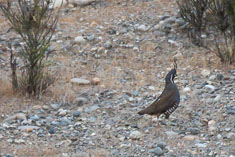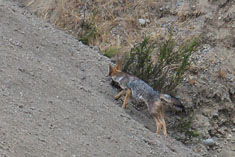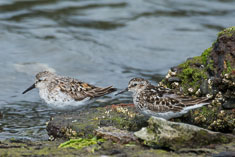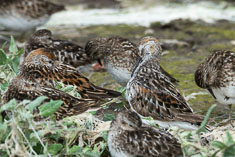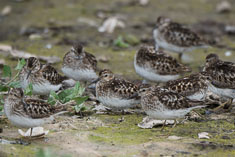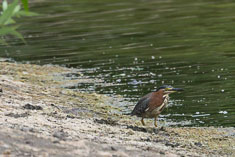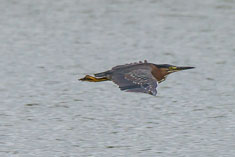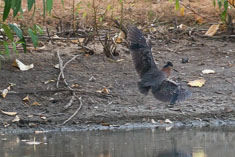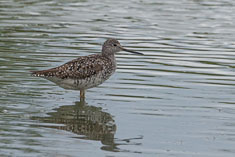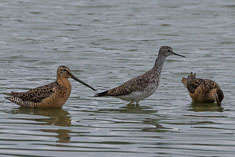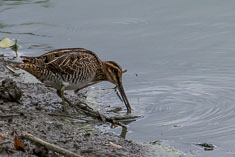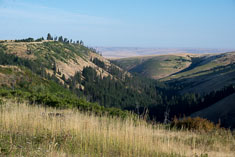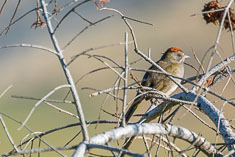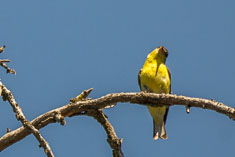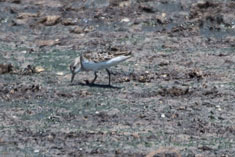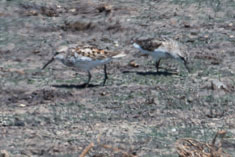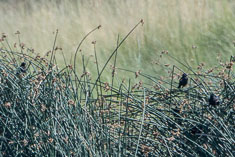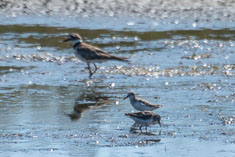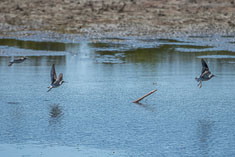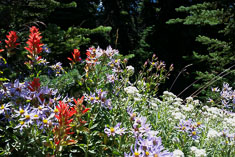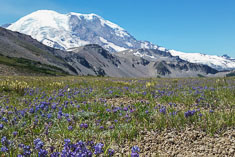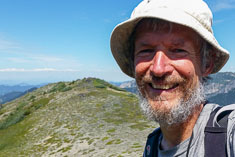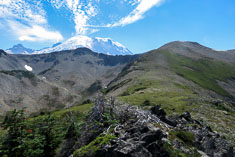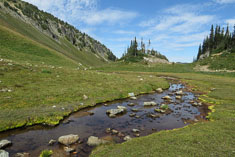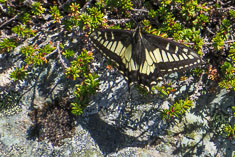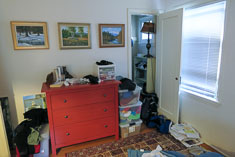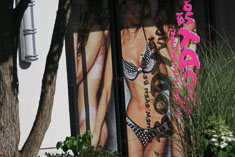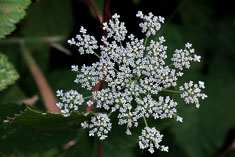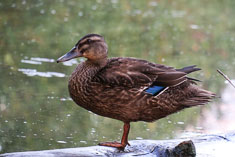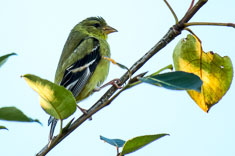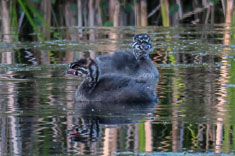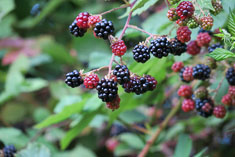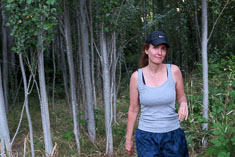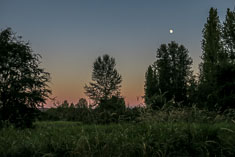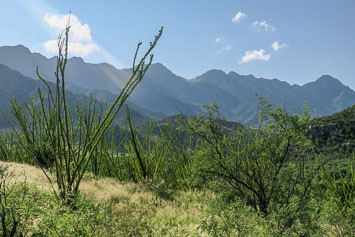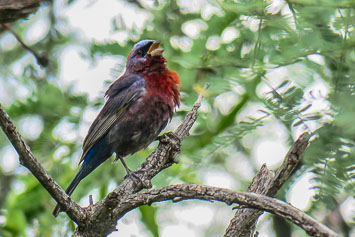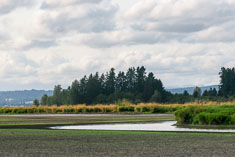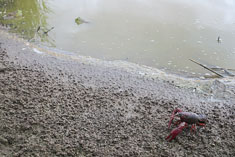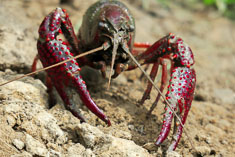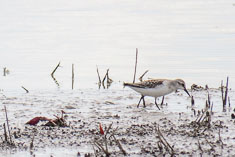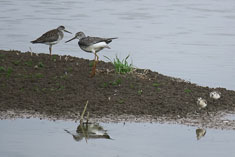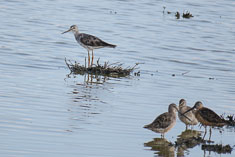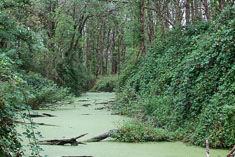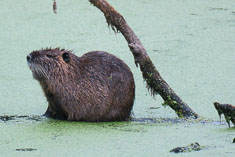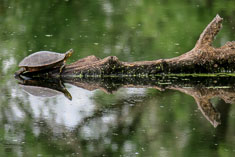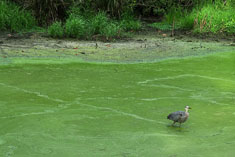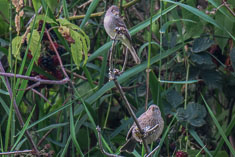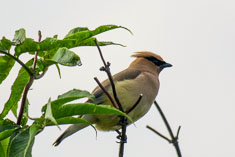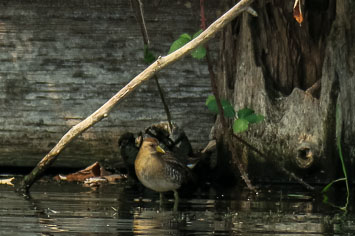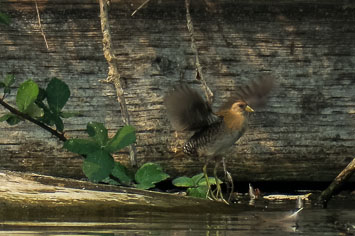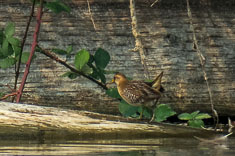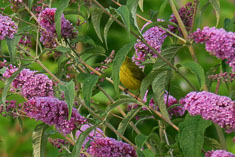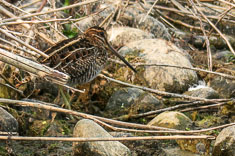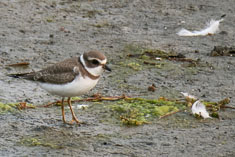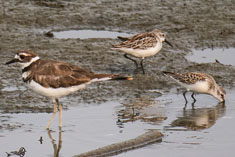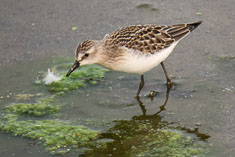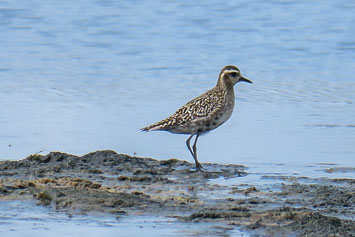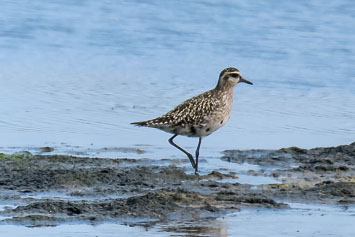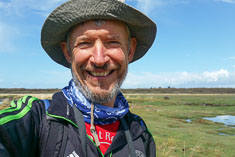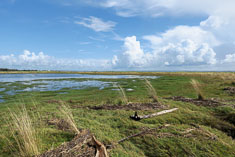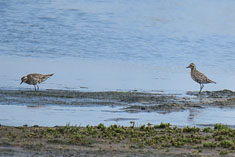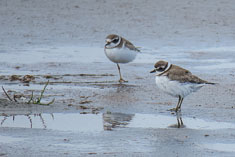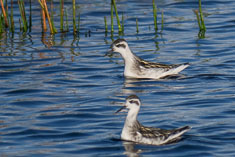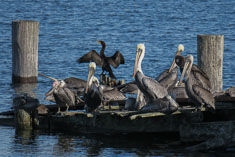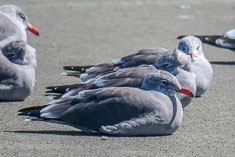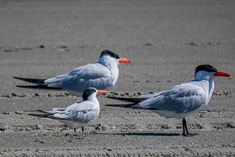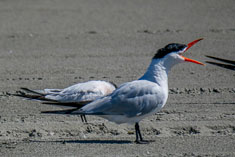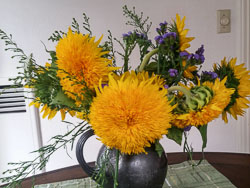6/23/2015 Sunrise hike 1
No White-tailed Ptarmigan have been reported from Sunrise this year and I hoped to remedy that. Years ago when the boys were in Pathfinders, I did a loop up over Third Burrows from Glacier Basin. That hike from White River campground would have been reasonable had I started at a reasonable hour, but I didn't leave the car till after three. Because of my late start I did the hike in reverse figuring that it would be easier after dark to walk down the Glacier Basin trail than down from Sunrise. I didn't see any White-tailed Ptarmigan but I did find a couple of Pine Grosbeaks not far below the junction with with the trail from the Sunrise parking lot. The grosbeaks were my 300th species for the year in Washington state, and with them I achieved my primary birding goal for the year.
I ate a late lunch at the Sunrise campground in the bright hot sunshine. A few tiny mosquitoes, very quick but not fortunately not very hungry, kept me company. Anticipating them, I'd bathed in bug dope down at the parking lot so they didn't bother me much. Fox sparrows were singing at the next trail junction. The initial couple notes of the song are quite similar to the "whip three beers" call of an Olive-sided Flycatcher. The snowpack is gone a month early this year so the flowers are starting to come out - magenta paintbrush, blue Veronica, Lupine and Fleabane and lots more. Around Frozen Lake the dwarf lupine and scarlet paintbrush are just starting to flower. I took pictures.
Starting up First Burrows, I heard "jrp jrp" calls from a couple of good-sized finches flying across the slope above me. They weren't Pine Grosbeaks and they weren't Cassins Finches or Red Crossbills. I suspected they were rosy finches which would have been another year bird, but after they landed I couldn't find them. Instead I saw a couple of mountain bluebirds, unusual this early at Sunrise according to eBird. Approaching the top of First Burrows the trail crossed a a small patch of snow steep enough that a track had developed around it. On top there were flowers amidst the sparse grass but they weren't very showy. Like that mountain itself.
Second Burroughs is a bit more of a mountain. Though just a flat-topped ridge, at least it's not a big plateau like First Burroughs. Third Burroughs actually has a identifiable peak but I didn't make it that far. It was 8 o'clock when I reached Second Burroughs so I hung out for a little while and admired the view before starting down the trail to Glacier Basin. Just past the top of Second Burroughs the flowers were dazzling but I didn't take any pictures because it was getting late. Next time.
Nice views of Rainier, and also a bull elk in velvet, from the trail down to Glacier Basin from Second Burroughs.
Beyond the elk a mule deer was moseying through the woods, then a cow elk dashed across a meadow. Most exciting though was a mama bear and cub(s) which suddenly appeared in the trail ahead of me at dusk. I backed up out of sight and dug my flashlight out of my pack then waited five minutes before starting cautiously down the trail again, singing and shouting and flashing my light all around. I was glad that nobody but the bears was around to hear me. I thought maybe I heard them again, down below the trail about where I'd seen them, but I kept up my racket for a good half-mile or more. In an avalanche clearing not far beyond the bears I spotted their tracks in the sandy trail bed. At first I was alarmed when the track seemed to be headed down the trail in front of me, then I was reassured to see the tracks headed back up the trail behind me. Apparently they'd spent some time foraging the clearing before I met them.
No White-tailed Ptarmigan have been reported from Sunrise this year and I hoped to remedy that. Years ago when the boys were in Pathfinders, I did a loop up over Third Burrows from Glacier Basin. That hike from White River campground would have been reasonable had I started at a reasonable hour, but I didn't leave the car till after three. Because of my late start I did the hike in reverse figuring that it would be easier after dark to walk down the Glacier Basin trail than down from Sunrise. I didn't see any White-tailed Ptarmigan but I did find a couple of Pine Grosbeaks not far below the junction with with the trail from the Sunrise parking lot. The grosbeaks were my 300th species for the year in Washington state, and with them I achieved my primary birding goal for the year.
I ate a late lunch at the Sunrise campground in the bright hot sunshine. A few tiny mosquitoes, very quick but not fortunately not very hungry, kept me company. Anticipating them, I'd bathed in bug dope down at the parking lot so they didn't bother me much. Fox sparrows were singing at the next trail junction. The initial couple notes of the song are quite similar to the "whip three beers" call of an Olive-sided Flycatcher. The snowpack is gone a month early this year so the flowers are starting to come out - magenta paintbrush, blue Veronica, Lupine and Fleabane and lots more. Around Frozen Lake the dwarf lupine and scarlet paintbrush are just starting to flower. I took pictures.
Starting up First Burrows, I heard "jrp jrp" calls from a couple of good-sized finches flying across the slope above me. They weren't Pine Grosbeaks and they weren't Cassins Finches or Red Crossbills. I suspected they were rosy finches which would have been another year bird, but after they landed I couldn't find them. Instead I saw a couple of mountain bluebirds, unusual this early at Sunrise according to eBird. Approaching the top of First Burrows the trail crossed a a small patch of snow steep enough that a track had developed around it. On top there were flowers amidst the sparse grass but they weren't very showy. Like that mountain itself.
Second Burroughs is a bit more of a mountain. Though just a flat-topped ridge, at least it's not a big plateau like First Burroughs. Third Burroughs actually has a identifiable peak but I didn't make it that far. It was 8 o'clock when I reached Second Burroughs so I hung out for a little while and admired the view before starting down the trail to Glacier Basin. Just past the top of Second Burroughs the flowers were dazzling but I didn't take any pictures because it was getting late. Next time.
Nice views of Rainier, and also a bull elk in velvet, from the trail down to Glacier Basin from Second Burroughs.
Beyond the elk a mule deer was moseying through the woods, then a cow elk dashed across a meadow. Most exciting though was a mama bear and cub(s) which suddenly appeared in the trail ahead of me at dusk. I backed up out of sight and dug my flashlight out of my pack then waited five minutes before starting cautiously down the trail again, singing and shouting and flashing my light all around. I was glad that nobody but the bears was around to hear me. I thought maybe I heard them again, down below the trail about where I'd seen them, but I kept up my racket for a good half-mile or more. In an avalanche clearing not far beyond the bears I spotted their tracks in the sandy trail bed. At first I was alarmed when the track seemed to be headed down the trail in front of me, then I was reassured to see the tracks headed back up the trail behind me. Apparently they'd spent some time foraging the clearing before I met them.
6/25/2015 Sunrise hike 2
Having neither found a Ptarmigan nor made it to Third Burrows two days ago, I decided to try again. David joined me and we set out from Sunrise around 2 PM. Once again I found it much easier to be at Sunrise at sunset rather than at sunrise.
We ate our lunch in the car in the parking lot then hiked up to Second Burroughs via Sunrise Campground and Frozen Lake. This time I stopped to photograph the flowers on Second Burroughs before continuing on. David stayed at Second Burroughs to take a nap but the breeze and the mosquitos alternately conspired to keep him awake so after a while he gave up and wandered around taking photos. I kept track of him by his bright white shirt.
The alpine flowers alone were worth the trip. Though there was some overlap, each summit had its own character. Inconspicuous flowers on one, brilliant reds and yellows on two and mostly blues and yellows on three.
Again today I found no Ptarmigan but I did get several good views of Gray-crowned Rosy Finches, year bird number 301. Unfortunately no photos of them but I did get photos of adult and juvenile Horned Larks, birds of arid steppes which apparently find alpine meadows a close enough substitute. Mountain goats were everywhere in herds and small groups. I counted more than two dozen adults and most of them had kids. Having not seen any two days ago, I wondered where they all came from.
The views of Mount Rainier were of course stunning. Despite having more than enough photos of Rainier from previous trips, we couldn't resist taking more. Even on the way down we kept looking over our shoulders at the mountain.
We left the Sunrise parking lot at 8:20PM and squeaked into Ranchitos in Enumclaw just before they closed. I had a Negro Modelo, basically a cross between an amber ale and a Coke, with my chicken enchiladas. It was a good day.
Having neither found a Ptarmigan nor made it to Third Burrows two days ago, I decided to try again. David joined me and we set out from Sunrise around 2 PM. Once again I found it much easier to be at Sunrise at sunset rather than at sunrise.
We ate our lunch in the car in the parking lot then hiked up to Second Burroughs via Sunrise Campground and Frozen Lake. This time I stopped to photograph the flowers on Second Burroughs before continuing on. David stayed at Second Burroughs to take a nap but the breeze and the mosquitos alternately conspired to keep him awake so after a while he gave up and wandered around taking photos. I kept track of him by his bright white shirt.
The alpine flowers alone were worth the trip. Though there was some overlap, each summit had its own character. Inconspicuous flowers on one, brilliant reds and yellows on two and mostly blues and yellows on three.
Again today I found no Ptarmigan but I did get several good views of Gray-crowned Rosy Finches, year bird number 301. Unfortunately no photos of them but I did get photos of adult and juvenile Horned Larks, birds of arid steppes which apparently find alpine meadows a close enough substitute. Mountain goats were everywhere in herds and small groups. I counted more than two dozen adults and most of them had kids. Having not seen any two days ago, I wondered where they all came from.
The views of Mount Rainier were of course stunning. Despite having more than enough photos of Rainier from previous trips, we couldn't resist taking more. Even on the way down we kept looking over our shoulders at the mountain.
We left the Sunrise parking lot at 8:20PM and squeaked into Ranchitos in Enumclaw just before they closed. I had a Negro Modelo, basically a cross between an amber ale and a Coke, with my chicken enchiladas. It was a good day.
6/28/2015 Vesper Peak
Several decades ago I hiked up Vesper peak and I remember white granite ledges and classic Cascades alpine scenery. And also White tailed Ptarmigan. As I recall it wasn't a particularly difficult hike, and didn't require scrambling, for which my nearly defunct arms are now ill-suited. The boys and I hiked up as far as the lake last November and though I climbed up to the ridge above the lake I didn't have time to get to the summit. Today I did.
Darchelle and I are doing progressively more difficult hikes, and I thought this might be a good next step after our Sunrise hike last week. Though the elevation and distance today were not much more than last week, the trail was rocky and the ledges more difficult than I remembered. The scenery was great but Darchelle found the scrambling a little intimidating and the rough trail tough on her knees and feet. In addition the temperature during the first couple miles of the hike was almost stifling, as warm as any hike I can recall in the Cascades.
Our first real stop was at the hidden ice cave in the hanging valley, about 2 miles up the trail. The cave was quite spectacular last November when the boys and I explored it. Then it was perhaps 100 feet long and 30 feet wide with walls and ceiling of scalloped blue ice 8 feet overhead. Now it is collapsed, a jumble of rounded blocks of white ice. Apparently the collapse occurred within the past two weeks, based on some photos I found on the Internet. I found it hard to believe that the cave could have melted out so much since last November, but I guess with recent temperatures consistently in the 80's, even glacial ice goes fast.
The switchbacks at the start of the climb to Headlee Pass were partly eroded away and a bit dicey in running shoes. About half way up I thought I heard a couple of White-winged Crossbill calls but couldn't verify them. Otherwise my bird list was pretty typical for the time and place.
The trail up the ridge on the far side of the lake outlet stream is particularly scenic with scattered old Mountain Hemlock, outcrops of white granite and drifts of blue lupine and red mountain heath. The ledges began above a band of krumholz and are for the most part just gentle enough to walk up. I drank from icy snowmelt streams trickling down over the granite and admired the views across to Sperry and Glacier peaks and east to Big Snow Mountain and its neighbors. The area just below the summit is a true alpine garden with myriad flowers tended by a lone Rosy Finch. We parked in the lee of the summit crag and peered over the edge at the massive slab of rock plummeting into the cirque above Copper Lake. Nearly all the snow has already melted off the glacier which has yet another two months to bake in the summer sunshine. I marveled at the polished granite ridge between Vesper and Big Four and wondered if there is any way I could get over there to explore. I doubt it. We took pictures and Darchelle fretted when I stood too close to the edge.
Concerned about her sore knee, she began her descent while I explored a little more around the summit. The other hikers started down. A breeze rustled silently around the summit boulders and the clouds overhead stood still. I photographed flowers, including a showy bluebell species which I don't recall seeing before. The rosy finch came and went. A couple of goats ambled along the ridge to the south but the Ptarmigan, if present, remained undetectable. I'll bet they were over to the left, on the ridge above the lake which I didn't have time to explore.
Several decades ago I hiked up Vesper peak and I remember white granite ledges and classic Cascades alpine scenery. And also White tailed Ptarmigan. As I recall it wasn't a particularly difficult hike, and didn't require scrambling, for which my nearly defunct arms are now ill-suited. The boys and I hiked up as far as the lake last November and though I climbed up to the ridge above the lake I didn't have time to get to the summit. Today I did.
Darchelle and I are doing progressively more difficult hikes, and I thought this might be a good next step after our Sunrise hike last week. Though the elevation and distance today were not much more than last week, the trail was rocky and the ledges more difficult than I remembered. The scenery was great but Darchelle found the scrambling a little intimidating and the rough trail tough on her knees and feet. In addition the temperature during the first couple miles of the hike was almost stifling, as warm as any hike I can recall in the Cascades.
Our first real stop was at the hidden ice cave in the hanging valley, about 2 miles up the trail. The cave was quite spectacular last November when the boys and I explored it. Then it was perhaps 100 feet long and 30 feet wide with walls and ceiling of scalloped blue ice 8 feet overhead. Now it is collapsed, a jumble of rounded blocks of white ice. Apparently the collapse occurred within the past two weeks, based on some photos I found on the Internet. I found it hard to believe that the cave could have melted out so much since last November, but I guess with recent temperatures consistently in the 80's, even glacial ice goes fast.
The switchbacks at the start of the climb to Headlee Pass were partly eroded away and a bit dicey in running shoes. About half way up I thought I heard a couple of White-winged Crossbill calls but couldn't verify them. Otherwise my bird list was pretty typical for the time and place.
The trail up the ridge on the far side of the lake outlet stream is particularly scenic with scattered old Mountain Hemlock, outcrops of white granite and drifts of blue lupine and red mountain heath. The ledges began above a band of krumholz and are for the most part just gentle enough to walk up. I drank from icy snowmelt streams trickling down over the granite and admired the views across to Sperry and Glacier peaks and east to Big Snow Mountain and its neighbors. The area just below the summit is a true alpine garden with myriad flowers tended by a lone Rosy Finch. We parked in the lee of the summit crag and peered over the edge at the massive slab of rock plummeting into the cirque above Copper Lake. Nearly all the snow has already melted off the glacier which has yet another two months to bake in the summer sunshine. I marveled at the polished granite ridge between Vesper and Big Four and wondered if there is any way I could get over there to explore. I doubt it. We took pictures and Darchelle fretted when I stood too close to the edge.
Concerned about her sore knee, she began her descent while I explored a little more around the summit. The other hikers started down. A breeze rustled silently around the summit boulders and the clouds overhead stood still. I photographed flowers, including a showy bluebell species which I don't recall seeing before. The rosy finch came and went. A couple of goats ambled along the ridge to the south but the Ptarmigan, if present, remained undetectable. I'll bet they were over to the left, on the ridge above the lake which I didn't have time to explore.
7/1-7/2015 Big Bend Trip
I had no expectation of ever getting to Big Bend National Park until a week ago when I had John over
and he mentioned that he was going to spend a week there after the conclusion of a three-day
conference in Austin. Having just served him dinner perhaps I took unfair advantage by suggesting
at that point that maybe he would like company. He agreed that would be okay. All I knew about Big
Bend was that Lucifer hummingbirds and Colima warblers lived there and that they had a Marathon in
March which had always filled up before I'd gotten around to registering. Here is a
journal of my week in Big Bend with John.
7/11/2015 Mountail Quail Redux
Blair is attempting to photograph every species he sees in Washington this year. He is only missing a half dozen or so, which is impressive considering that he is the #1 eBirder in the state with 327 species. BTW, I'm in the #2 place at the moment with 301 species. One of the species for which he did not have a photo was Mountain Quail, so when he saw that I had reported one recently he gave me a call. I suggested a day of birding together starting with a trip to the Port Orchard airport/quarry to look for Mountain Quail.
We parked at the usual spot across Sidney Rd SW from SW Lakeway Blvd and hiked west up the track towards the old clear-cut. Since my last visit the track has been bulldozed all the way to the quarry, completely eliminating the need to bushwhack. Convenient for access, but the development it portends probably spells the end for the Mountain Quail population on the site. I don't know where else to find them, but on the other hand a year from now I probably won't be looking for them any longer. Today we saw three and we both got photos of one of them. We also saw a coyote, Public Enemy Number One from the quail's perspective, down in the quarry within 100 feet of where we saw the quail.
I was looking for a Semipalmated sandpiper. They're coming through with Western and Least sandpipers but I haven't seen one yet this year. First we tried the Hylebos bridge in Tacoma, a spot I recognized once we got there. At first we didn't see much, then we found whole flock of Western and Least sandpipers roosting out on the point. They allowed us to get very close and I took lots of photos. The Westerns are still mostly in breeding plumage so they have varying amounts of rufous on the crown and scapulars. That distinguishes them from Semipalmated sandpipers which have no rufous. The Least sandpipers were much darker brown than I expected, with little evidence of the buffy scapulars by which I usually identify them. There were no Semipalmated sandpipers in the flock.
Not ready to give up, we drove over to Levee Pond Park, another good shorebirding spot during fall migration. There we found a nice mix of shorebirds but still no Semipalmated sandpipers. The snipe was wading out in the water like the dowitchers and fooled us both until Blair looked at his photos from the day. I lugged around my D600 with the 80-400 mm lens on the monopod and though it was a lot of work, the image quality is far superior to the SX280. I wouldn't mind finding something in between the two.
Blair is attempting to photograph every species he sees in Washington this year. He is only missing a half dozen or so, which is impressive considering that he is the #1 eBirder in the state with 327 species. BTW, I'm in the #2 place at the moment with 301 species. One of the species for which he did not have a photo was Mountain Quail, so when he saw that I had reported one recently he gave me a call. I suggested a day of birding together starting with a trip to the Port Orchard airport/quarry to look for Mountain Quail.
We parked at the usual spot across Sidney Rd SW from SW Lakeway Blvd and hiked west up the track towards the old clear-cut. Since my last visit the track has been bulldozed all the way to the quarry, completely eliminating the need to bushwhack. Convenient for access, but the development it portends probably spells the end for the Mountain Quail population on the site. I don't know where else to find them, but on the other hand a year from now I probably won't be looking for them any longer. Today we saw three and we both got photos of one of them. We also saw a coyote, Public Enemy Number One from the quail's perspective, down in the quarry within 100 feet of where we saw the quail.
I was looking for a Semipalmated sandpiper. They're coming through with Western and Least sandpipers but I haven't seen one yet this year. First we tried the Hylebos bridge in Tacoma, a spot I recognized once we got there. At first we didn't see much, then we found whole flock of Western and Least sandpipers roosting out on the point. They allowed us to get very close and I took lots of photos. The Westerns are still mostly in breeding plumage so they have varying amounts of rufous on the crown and scapulars. That distinguishes them from Semipalmated sandpipers which have no rufous. The Least sandpipers were much darker brown than I expected, with little evidence of the buffy scapulars by which I usually identify them. There were no Semipalmated sandpipers in the flock.
Not ready to give up, we drove over to Levee Pond Park, another good shorebirding spot during fall migration. There we found a nice mix of shorebirds but still no Semipalmated sandpipers. The snipe was wading out in the water like the dowitchers and fooled us both until Blair looked at his photos from the day. I lugged around my D600 with the 80-400 mm lens on the monopod and though it was a lot of work, the image quality is far superior to the SX280. I wouldn't mind finding something in between the two.
7/17/2015 Birding with Blair Redux
Blair offered to show Melissa, a friend of his from BC, a Green-tailed Towhee and asked if I wanted to come along. I did, but more for the possibility of a Great Gray Owl or a Semipalmated Sandpiper. Blair himself was looking for Tricolored blackbirds for his year list and Ruffed Grouse for photos. The towhees in Washington occur only in the Blue Mountains near Walla Walla so that would be our starting point. Tricolored blackbirds have recently been reported only at Para Ponds near Othello, so we'd probably end up there.
So as to get an early start, we all spent the night at the Super 8 Motel in Walla Walla. At 6AM, the breakfast room was crowded with construction workers, a mix of old guys and college-age kids. I managed to retrieve my coffee and cereal without spilling anything on the floor and felt good about that. The guys, recognizing my disability, treated me with polite deference.
Blair drove us up the North Fork, by Creek Road and stopped at a clearing just short of the top. I was skeptical that we would find towhees there so I didn't get out my camera. That was a mistake. As soon as Blair played their song, one flew across the road in front of us and perched in plain sight not 20 feet away. Melissa didn't manage to get photos there either, so we stopped in a couple more places overlooking brushy canyon slopes and called up another towhee or two and both Melissa and I got pictures. No ruffed grouse for Blair, though we hiked a half-mile or so of road up in mixed coniferous forest. On the way back into town I suggested we stop at Rooks Park to see the Lesser Goldfinches which are apparently breeding there. To Melissa's delight and my relief, they cooperated. Blair and I left Melissa in Walla Walla. She wanted to go up Biscuit Ridge to look for more towhees. We wanted to check out the Dodd Road ponds for Semipalmated sandpipers and other shorebirds on the way up to Othello.
It's difficult to imagine a less appealing location for birdwatching then the Blood Ponds on Dodd Road. The Denny's had reported a Semipalmated sandpiper or two along with 742 Western and Least sandpipers just two days earlier so we had to stop and check them out. Dodd Road is a narrow two-lane road busy with heavy agricultural truck traffic. The south side of the road is lined with feedlots and a beef processing plant. On the north side of the road, the several Blood Ponds are presumably named for the watery nitrogenous waste sprayed and pumped into them periodically. As that dries, it forms a muddy crust which cracks and buckles to provide innumerable hiding places for small sandpipers. They emerge from hiding to scour and probe the damp surface, presumably for maggots. The sun was hot and bright when we stopped; heat waves made it difficult to scope the peeps and impossible to get good photographs, but having studied Western sandpipers for several hours yesterday at Perch Point, I immediately recognized the Semipalmated sandpipers when I spotted them among about 50 Westerns and Leasts. They're paler and grayer than Least sandpipers with a stouter bill which is somewhat shorter than even the shortest Western Sandpiper bill, and unlike most of the latter, they show no rufous on the crown or scapulars.
Regarding truck traffic, the Para Ponds are not much of an improvement over the Blood Ponds but at least they're somewhat more natural looking, with shallow water and exposed mud enclosed by rushes and cow pasture. There We found not only a dozen Tricolored blackbirds but also a satisfying selection of shorebirds, ten species including another Semipalmated Sandpiper and 20 Lesser Yellowlegs, the most I've ever seen in any one spot. I didn't get many photos because I elected to all the scope out of the car instead of the camera. Not until all the Tricolored blackbirds had finished displaying and the shorebirds been mostly scared off to a more distant pond by a passing truck did I get out my camera. Lighting conditions were tough anyhow, the birds backlit by bright sunlight. The all Tricolored blackbirds had a curious manner of either displaying or foraging. With wings drooping they tilt forward so their beaks are touching the ground and their tails sticking almost straight up in the air.
Continuing into the Columbia national wildlife refuge, we flushed a mystery grouse near the pond where I might have seen the Snowy Egret two years ago. It was the size of Dusky Grouse with black head and nape, chestnut side or front of neck, brown and gray streaked or scaled back, short dark tail and red or orange legs. It had a slight crest on its head like a Ruffed Grouse. I saw it very briefly on the ground and in flight from above and from behind, with covey of adult and young California Quail. Although it was presumably an escaped bird it was not at all tame. Neither of us had any idea what it was but the next day, perusing grouse photos on the Internet, I identified it as a Black Francolin, year bird #303 until eBird disallows it.
Blair offered to show Melissa, a friend of his from BC, a Green-tailed Towhee and asked if I wanted to come along. I did, but more for the possibility of a Great Gray Owl or a Semipalmated Sandpiper. Blair himself was looking for Tricolored blackbirds for his year list and Ruffed Grouse for photos. The towhees in Washington occur only in the Blue Mountains near Walla Walla so that would be our starting point. Tricolored blackbirds have recently been reported only at Para Ponds near Othello, so we'd probably end up there.
So as to get an early start, we all spent the night at the Super 8 Motel in Walla Walla. At 6AM, the breakfast room was crowded with construction workers, a mix of old guys and college-age kids. I managed to retrieve my coffee and cereal without spilling anything on the floor and felt good about that. The guys, recognizing my disability, treated me with polite deference.
Blair drove us up the North Fork, by Creek Road and stopped at a clearing just short of the top. I was skeptical that we would find towhees there so I didn't get out my camera. That was a mistake. As soon as Blair played their song, one flew across the road in front of us and perched in plain sight not 20 feet away. Melissa didn't manage to get photos there either, so we stopped in a couple more places overlooking brushy canyon slopes and called up another towhee or two and both Melissa and I got pictures. No ruffed grouse for Blair, though we hiked a half-mile or so of road up in mixed coniferous forest. On the way back into town I suggested we stop at Rooks Park to see the Lesser Goldfinches which are apparently breeding there. To Melissa's delight and my relief, they cooperated. Blair and I left Melissa in Walla Walla. She wanted to go up Biscuit Ridge to look for more towhees. We wanted to check out the Dodd Road ponds for Semipalmated sandpipers and other shorebirds on the way up to Othello.
It's difficult to imagine a less appealing location for birdwatching then the Blood Ponds on Dodd Road. The Denny's had reported a Semipalmated sandpiper or two along with 742 Western and Least sandpipers just two days earlier so we had to stop and check them out. Dodd Road is a narrow two-lane road busy with heavy agricultural truck traffic. The south side of the road is lined with feedlots and a beef processing plant. On the north side of the road, the several Blood Ponds are presumably named for the watery nitrogenous waste sprayed and pumped into them periodically. As that dries, it forms a muddy crust which cracks and buckles to provide innumerable hiding places for small sandpipers. They emerge from hiding to scour and probe the damp surface, presumably for maggots. The sun was hot and bright when we stopped; heat waves made it difficult to scope the peeps and impossible to get good photographs, but having studied Western sandpipers for several hours yesterday at Perch Point, I immediately recognized the Semipalmated sandpipers when I spotted them among about 50 Westerns and Leasts. They're paler and grayer than Least sandpipers with a stouter bill which is somewhat shorter than even the shortest Western Sandpiper bill, and unlike most of the latter, they show no rufous on the crown or scapulars.
Regarding truck traffic, the Para Ponds are not much of an improvement over the Blood Ponds but at least they're somewhat more natural looking, with shallow water and exposed mud enclosed by rushes and cow pasture. There We found not only a dozen Tricolored blackbirds but also a satisfying selection of shorebirds, ten species including another Semipalmated Sandpiper and 20 Lesser Yellowlegs, the most I've ever seen in any one spot. I didn't get many photos because I elected to all the scope out of the car instead of the camera. Not until all the Tricolored blackbirds had finished displaying and the shorebirds been mostly scared off to a more distant pond by a passing truck did I get out my camera. Lighting conditions were tough anyhow, the birds backlit by bright sunlight. The all Tricolored blackbirds had a curious manner of either displaying or foraging. With wings drooping they tilt forward so their beaks are touching the ground and their tails sticking almost straight up in the air.
Continuing into the Columbia national wildlife refuge, we flushed a mystery grouse near the pond where I might have seen the Snowy Egret two years ago. It was the size of Dusky Grouse with black head and nape, chestnut side or front of neck, brown and gray streaked or scaled back, short dark tail and red or orange legs. It had a slight crest on its head like a Ruffed Grouse. I saw it very briefly on the ground and in flight from above and from behind, with covey of adult and young California Quail. Although it was presumably an escaped bird it was not at all tame. Neither of us had any idea what it was but the next day, perusing grouse photos on the Internet, I identified it as a Black Francolin, year bird #303 until eBird disallows it.
7/19/2015 Fremont Lookout loop
David and I hiked from Sunrise out to the Fremont lookout in search of White-tailed Ptarmigan. We took the low route down the old road because I'd heard that Doug had photographed boreal owls somewhere in the area and I thought that perhaps if we could find their tracks we could follow them to the owl tree. Though we found tracks leading off into meadows and fir groves in several places, they all seem to peter out pretty quickly and we never found any owls. The flowers in the woods seem to be at their peak. Up around treeline the meadows are blue with lupine but the scarlet paintbrush have gone by. The snow patches around Frozen Lake and at the saddle above the lookout tower are almost completely gone.
The Ptarmigan, reported two days ago by the Fremont lookout, were also gone. We searched for them across the ridge to the east, dropped down into a rarely visited basin north over the ridge from frozen Lake then caught the Huckleberry Creek trail back up to Sunrise. It was a beautiful day but the contrasts between deep blue sky, bright white clouds and gleaming glaciers were too much for my SX280 so I used my phone quite a bit instead.
David and I hiked from Sunrise out to the Fremont lookout in search of White-tailed Ptarmigan. We took the low route down the old road because I'd heard that Doug had photographed boreal owls somewhere in the area and I thought that perhaps if we could find their tracks we could follow them to the owl tree. Though we found tracks leading off into meadows and fir groves in several places, they all seem to peter out pretty quickly and we never found any owls. The flowers in the woods seem to be at their peak. Up around treeline the meadows are blue with lupine but the scarlet paintbrush have gone by. The snow patches around Frozen Lake and at the saddle above the lookout tower are almost completely gone.
The Ptarmigan, reported two days ago by the Fremont lookout, were also gone. We searched for them across the ridge to the east, dropped down into a rarely visited basin north over the ridge from frozen Lake then caught the Huckleberry Creek trail back up to Sunrise. It was a beautiful day but the contrasts between deep blue sky, bright white clouds and gleaming glaciers were too much for my SX280 so I used my phone quite a bit instead.
7/27/2015 Canon G3X
I read about a new Canon super-zoom camera, the Powershot G3X, a couple of days ago on Tweeters. It just came out a month ago and uses a larger sensor than the SX280. On dpreview.com I compared sample photos from the G3X with the same photos from the SX280 and the D600. Though obviously not as good as the DSLR, the G3X images were considerably sharper with less noise than the SX280. The zoom range is greater too, equivalent to 25-600mm. I've been looking for a better lightweight camera option for shooting birds, particularly with my SE Arizona trip coming up, so I drove down to Glazer's and bought one. It was $1000 but time is rapidly running out for me to do bird photography and this might give me a few extra months, so I consider it money well spent. I also ordered the optional viewfinder and an extra battery from B&H photo for another $400.
Daniel's dresser, in my bedroom, was my first photo with the new camera. Shot at 25mm, hand held at 1/20 second with ISO at 800, noise is evident at full crop but only barely at 50% crop. Not bad. The Victoria's secret photo doesn't say much about the camera but I liked the subject. The Queen Anne's lace at 200 mm ISO 800 was almost as sharp as the same photo at 25 mm ISO 400 from the SX280. So far so good, but not exactly a compelling upgrade given the substantially larger size of the G3X.
The bird photos tell a different story. The Mallard was hand held at 1/8 second, about 280mm zoom. The Goldfinch was shot at 1/160 second at full 600mm zoom, overexposed by one-stop to compensate for the backlighting, then cropped by 50%. The feather detail is excellent, there is almost no chromatic aberration, and neither noise nor noise reduction smearing is problematic even at 100% crop. The grebelets were shot at ISO 640 in shadow near sunset, at 600mm zoom. Detail and noise are both significantly better than I could have achieved with the SX280, though the new camera shares with the SX280 the same difficulty in locating the subject and getting precise focus. Despite those issues this camera will work for my bird photography, and I will be able to continue using it for some time after I can no longer handle the D600.
I read about a new Canon super-zoom camera, the Powershot G3X, a couple of days ago on Tweeters. It just came out a month ago and uses a larger sensor than the SX280. On dpreview.com I compared sample photos from the G3X with the same photos from the SX280 and the D600. Though obviously not as good as the DSLR, the G3X images were considerably sharper with less noise than the SX280. The zoom range is greater too, equivalent to 25-600mm. I've been looking for a better lightweight camera option for shooting birds, particularly with my SE Arizona trip coming up, so I drove down to Glazer's and bought one. It was $1000 but time is rapidly running out for me to do bird photography and this might give me a few extra months, so I consider it money well spent. I also ordered the optional viewfinder and an extra battery from B&H photo for another $400.
Daniel's dresser, in my bedroom, was my first photo with the new camera. Shot at 25mm, hand held at 1/20 second with ISO at 800, noise is evident at full crop but only barely at 50% crop. Not bad. The Victoria's secret photo doesn't say much about the camera but I liked the subject. The Queen Anne's lace at 200 mm ISO 800 was almost as sharp as the same photo at 25 mm ISO 400 from the SX280. So far so good, but not exactly a compelling upgrade given the substantially larger size of the G3X.
The bird photos tell a different story. The Mallard was hand held at 1/8 second, about 280mm zoom. The Goldfinch was shot at 1/160 second at full 600mm zoom, overexposed by one-stop to compensate for the backlighting, then cropped by 50%. The feather detail is excellent, there is almost no chromatic aberration, and neither noise nor noise reduction smearing is problematic even at 100% crop. The grebelets were shot at ISO 640 in shadow near sunset, at 600mm zoom. Detail and noise are both significantly better than I could have achieved with the SX280, though the new camera shares with the SX280 the same difficulty in locating the subject and getting precise focus. Despite those issues this camera will work for my bird photography, and I will be able to continue using it for some time after I can no longer handle the D600.
7/28/2015 Blackberries
Darchelle and I walked onto Magnuson Park this evening to check out the blackberries, and so I could take a few more pictures with the new camera. I leave in two days and I need all the practice with the camera that I can get. The blackberries are well ahead of schedule. Hot and dry conditions have produced undersized and somewhat bitter berries on many of the canes but we found a few good patches and other people were out picking. My berry picking is limited; I can't raise my hands above my waist except by swinging them up to my chin, not a good move in a thorny blackberry ticket. With substantial effort, I can reach out a couple of inches at the level of my crotch. I can do a little better with berries that are at knee height or underfoot though even then picking is slow because my fingers don't move quickly. I can still eat blackberry pie though, providing Darchelle picks the berries and the next door neighbor bakes the pie.
Darchelle and I walked onto Magnuson Park this evening to check out the blackberries, and so I could take a few more pictures with the new camera. I leave in two days and I need all the practice with the camera that I can get. The blackberries are well ahead of schedule. Hot and dry conditions have produced undersized and somewhat bitter berries on many of the canes but we found a few good patches and other people were out picking. My berry picking is limited; I can't raise my hands above my waist except by swinging them up to my chin, not a good move in a thorny blackberry ticket. With substantial effort, I can reach out a couple of inches at the level of my crotch. I can do a little better with berries that are at knee height or underfoot though even then picking is slow because my fingers don't move quickly. I can still eat blackberry pie though, providing Darchelle picks the berries and the next door neighbor bakes the pie.
8/1-10/2015 SE Arizona Trip
I spent the first ten days of August birding and photographing birds in SE Arizona. Here is a journal of my SE Arizona trip.
I spent the first ten days of August birding and photographing birds in SE Arizona. Here is a journal of my SE Arizona trip.
8/22/2015 Cedar River, Mount Margaret
I met Ed and Delia at their house this morning at 8:30 and we drove down to the Cedar River mouth where both Baird's and Stilt Sandpipers have been reported recently. Neither was among the 10 species of shorebirds we found there, but we got good close up photos of a Semipalmated Sandpiper on the mud flats and somewhat more distant photos of a juvenile Sora foraging along the far bank Cedar River, sheltered by a blackberry hedge from the jet wash of planes taking off from the adjacent runway. We dropped our binoculars to plug our ears with our fingers as they roared overhead.
I had planned earlier in the week to go down to Ocean Shores. A Lesser Sand Plover was hanging out on the beach and I could have seen it if I had gone down on Wednesday. I didn't feel like going alone so I stayed home instead and then was unhappy that I missed the sand plover and other year birds down there. This morning I realized about the pleasure of company takes away the disappointment of missing the target birds.
Distracted by peeps on a gravel bar a few hundred yards up from the lake, mostly Least Sandpipers I think, we left late so I was late for my haircut and late for lunch with Darchelle and Ellen at the Royal Palm. The haircut wasn't quite what I wanted, hair too short and beard too long, but I was too timid to ask her to trim my beard shorter. Darchelle had ordered eggplant for me , normally a good choice but it was a little too salty. I ate a little too much so had to take a nap afterwards.
Around 5PM I set out for the Mount Margaret trailhead near Snoqualmie Pass. The mountains were hazy from the smoke that has blanketed the Puget Sound all day long, tinting the sunlight orange and coloring the sky white. Visibility was only about five miles; from Gold Creek, Alta was visible but Chikamin Peak was not. I could smell the smoke when I started up from the trailhead, like a campfire nearby. In the past week 250,000 acres have burned in the Methow and Okanogan valleys. I grieve for the forests, which won't regain their diversity and beauty for generations, if not centuries.
Mount margaret is my go-to spot for huckleberries and boletes but I found neither. The soil was actually damp in places so perhaps it is too early for the mushrooms. I think they usually come up around Labor Day. The huckleberry leaves were curling and turning red, probably from drought, and there were no berries at all.
I met Ed and Delia at their house this morning at 8:30 and we drove down to the Cedar River mouth where both Baird's and Stilt Sandpipers have been reported recently. Neither was among the 10 species of shorebirds we found there, but we got good close up photos of a Semipalmated Sandpiper on the mud flats and somewhat more distant photos of a juvenile Sora foraging along the far bank Cedar River, sheltered by a blackberry hedge from the jet wash of planes taking off from the adjacent runway. We dropped our binoculars to plug our ears with our fingers as they roared overhead.
I had planned earlier in the week to go down to Ocean Shores. A Lesser Sand Plover was hanging out on the beach and I could have seen it if I had gone down on Wednesday. I didn't feel like going alone so I stayed home instead and then was unhappy that I missed the sand plover and other year birds down there. This morning I realized about the pleasure of company takes away the disappointment of missing the target birds.
Distracted by peeps on a gravel bar a few hundred yards up from the lake, mostly Least Sandpipers I think, we left late so I was late for my haircut and late for lunch with Darchelle and Ellen at the Royal Palm. The haircut wasn't quite what I wanted, hair too short and beard too long, but I was too timid to ask her to trim my beard shorter. Darchelle had ordered eggplant for me , normally a good choice but it was a little too salty. I ate a little too much so had to take a nap afterwards.
Around 5PM I set out for the Mount Margaret trailhead near Snoqualmie Pass. The mountains were hazy from the smoke that has blanketed the Puget Sound all day long, tinting the sunlight orange and coloring the sky white. Visibility was only about five miles; from Gold Creek, Alta was visible but Chikamin Peak was not. I could smell the smoke when I started up from the trailhead, like a campfire nearby. In the past week 250,000 acres have burned in the Methow and Okanogan valleys. I grieve for the forests, which won't regain their diversity and beauty for generations, if not centuries.
Mount margaret is my go-to spot for huckleberries and boletes but I found neither. The soil was actually damp in places so perhaps it is too early for the mushrooms. I think they usually come up around Labor Day. The huckleberry leaves were curling and turning red, probably from drought, and there were no berries at all.
8/23/2015 Morning
I awoke this morning from a happy dream though I could not recall the details. When I sat up to get out of bed, I felt the weakness in my arms and was sad, realizing again that this is my reality, and from it there is no escape. Doctors can't fix it and there is no longer any magic in God.
I pulled my shorts up to my crotch and grabbed the waistband in back with my fingers, braced my knuckles on the edge of the counter and squatted down to into drop my butt my shorts. Then I turned around and with my left hand pinned the left side of the snap to the countertop, squatted down a bit to raise my shorts as high as they would go and with my right hand slid the right side of the snap across the countertop and into place on top of the left. It took several tries. Then I pressed down with all my strength using both thumbs to pop the snap together. After that the zipper was pretty easy. The belt buckle is tough so since I wasn't going out of the house I just left it for later.
My arms were feeling pretty good. I've noticed recently that my arms feel somewhat better the day after a hike so I try to to take advantage of that, this morning by cooking breakfast. I chopped and sauteed some sweet onion, added some morels that I froze back in May and some black sticky rice left over from a couple of days ago. Seasoned with salt, pepper, basil and nutmeg, it was quite tasty. I decided to try an omelet as well. I used to enjoy making them but now the physical effort is generally too much. Cracking the eggs I mangled one of them but was able to salvage it. Grabbing a fork with both fists, I pushed the yolks around the bowl a few times before getting up to speed. I beat them pretty well. I didn't even come close to dropping the pan while cooking the omelet but I turned the burner off a little too soon and had to finish it up under the broiler. I added tomato and cheese for the last minute. The eggs were nice and light but the flavor was a bit disappointing. I think maybe the tomatoes weren't sweet enough. Sitting in my little dining room with the yellowish sunlight slipping in through the bay windows, sipping my strong coffee and eating my morel-flavored rice and my so-so tomato omelet, I felt something akin to joy.
I awoke this morning from a happy dream though I could not recall the details. When I sat up to get out of bed, I felt the weakness in my arms and was sad, realizing again that this is my reality, and from it there is no escape. Doctors can't fix it and there is no longer any magic in God.
I pulled my shorts up to my crotch and grabbed the waistband in back with my fingers, braced my knuckles on the edge of the counter and squatted down to into drop my butt my shorts. Then I turned around and with my left hand pinned the left side of the snap to the countertop, squatted down a bit to raise my shorts as high as they would go and with my right hand slid the right side of the snap across the countertop and into place on top of the left. It took several tries. Then I pressed down with all my strength using both thumbs to pop the snap together. After that the zipper was pretty easy. The belt buckle is tough so since I wasn't going out of the house I just left it for later.
My arms were feeling pretty good. I've noticed recently that my arms feel somewhat better the day after a hike so I try to to take advantage of that, this morning by cooking breakfast. I chopped and sauteed some sweet onion, added some morels that I froze back in May and some black sticky rice left over from a couple of days ago. Seasoned with salt, pepper, basil and nutmeg, it was quite tasty. I decided to try an omelet as well. I used to enjoy making them but now the physical effort is generally too much. Cracking the eggs I mangled one of them but was able to salvage it. Grabbing a fork with both fists, I pushed the yolks around the bowl a few times before getting up to speed. I beat them pretty well. I didn't even come close to dropping the pan while cooking the omelet but I turned the burner off a little too soon and had to finish it up under the broiler. I added tomato and cheese for the last minute. The eggs were nice and light but the flavor was a bit disappointing. I think maybe the tomatoes weren't sweet enough. Sitting in my little dining room with the yellowish sunlight slipping in through the bay windows, sipping my strong coffee and eating my morel-flavored rice and my so-so tomato omelet, I felt something akin to joy.
9/07/2015 Arranging flowers with ALS
Yesterday at the Ballard farmers market, I bought a large bunch of flowers for Darchelle, to welcome her home from her trip to Walla Walla. I chose sunflowers because she likes yellows and reds. Unfortunately they were too top heavy even for the largest vase I had so this morning I decided to trim the stems. Because I was unable to flex my arms to lift the vase into the sink, I climbed up on to the low stool that I sometimes use for working in the sink. I pulled the flowers out of the vase and trimmed the stems one at a time, pressing the handles of the scissors against the bottom of the sink to make the cuts then replacing the stems in the vase. As I was finishing up the arrangement I leaned over too far. The stool slid out from under my feet and I fell forward into the sink. Unable to stop myself with my useless arms, my forehead hit the backsplash tiles as my jaw struck the hot water handle and my shoulder slammed into the sunflower bouquet. Only the flowers were damaged; I was fortunately not seriously hurt, just angry once again about this damned disease.
Yesterday at the Ballard farmers market, I bought a large bunch of flowers for Darchelle, to welcome her home from her trip to Walla Walla. I chose sunflowers because she likes yellows and reds. Unfortunately they were too top heavy even for the largest vase I had so this morning I decided to trim the stems. Because I was unable to flex my arms to lift the vase into the sink, I climbed up on to the low stool that I sometimes use for working in the sink. I pulled the flowers out of the vase and trimmed the stems one at a time, pressing the handles of the scissors against the bottom of the sink to make the cuts then replacing the stems in the vase. As I was finishing up the arrangement I leaned over too far. The stool slid out from under my feet and I fell forward into the sink. Unable to stop myself with my useless arms, my forehead hit the backsplash tiles as my jaw struck the hot water handle and my shoulder slammed into the sunflower bouquet. Only the flowers were damaged; I was fortunately not seriously hurt, just angry once again about this damned disease.
